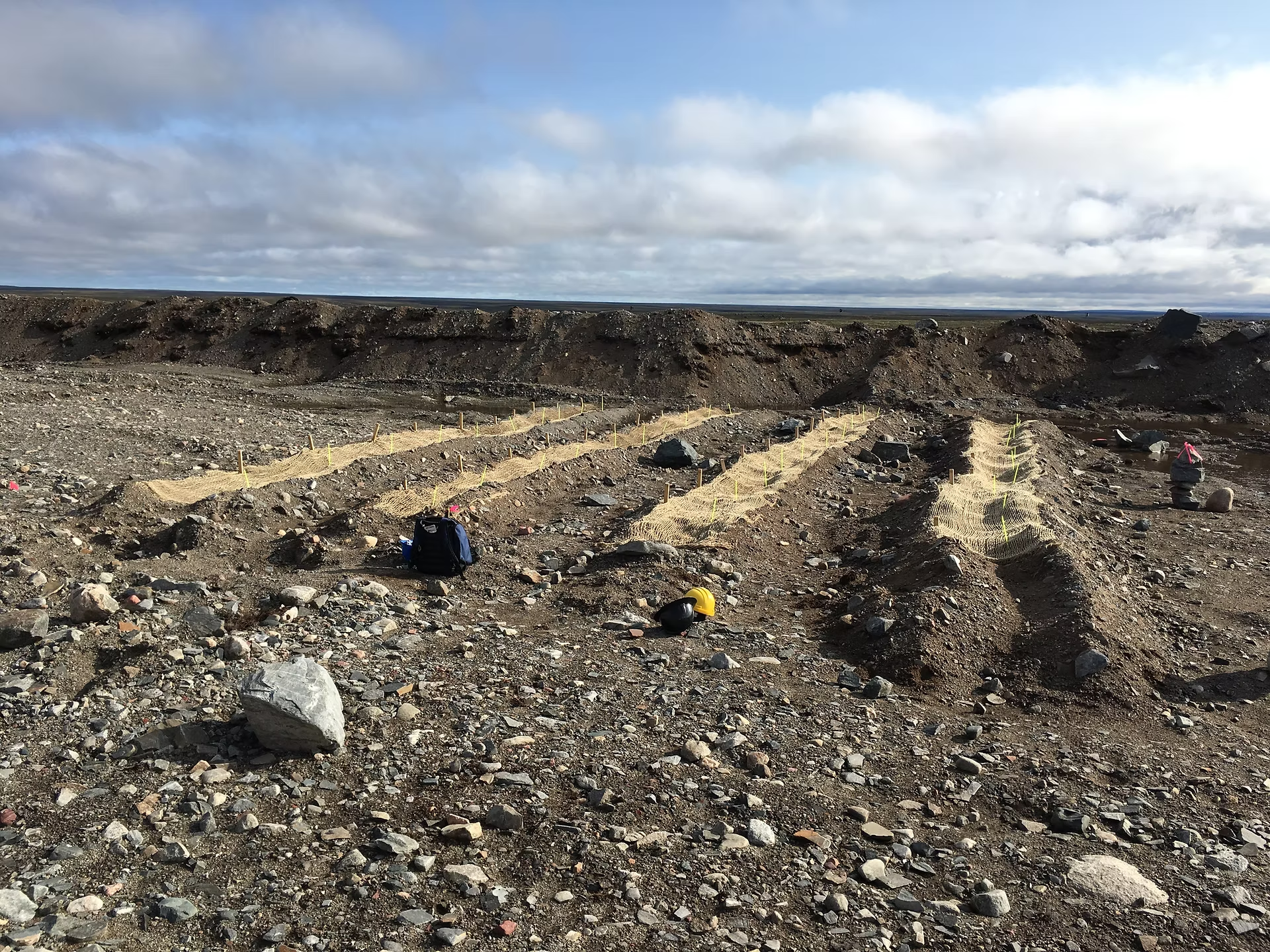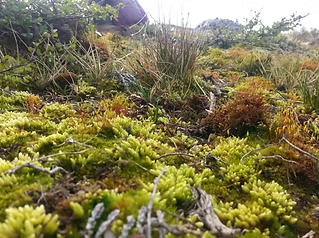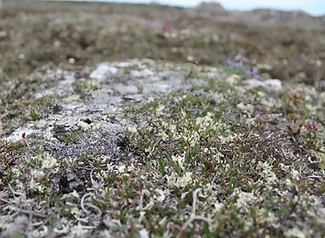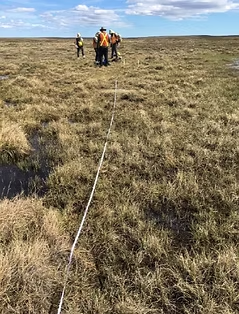

Background
Both past mineral exploration drilling and proposed operations have and will impact the tundra environment at AEM's Meliadine site. With on-going mining and mine development in the North, there is a strong need for site-specific tundra restoration techniques. Seeding and fertilization is commonly used in many revegetation efforts. However, the ecological and economic feasibility of this approach in northern tundra environments is limited due to the lack of commercial seed stocks for northern native tundra vegetation and isolated site locations. To establish natural successional trajectories and promote key ecosystem processes, we will develop restoration techniques reliant only on materials available on-site.

Specifically, we will examine the potential for local Biological Soil Crusts (BSCs i.e. communities of bryophytes, lichens, cyanobacteria, bacteria, fungi and archaea etc.) and tundra surface organic layers (i.e. the upper section of the active layer including all seed bank and rhizomatous materials) to foster the development of pre-disturbance arctic community assemblages and recovery of essential ecosystem functions.

Preliminary work
In the summer of 2018, we examined a total of 25 drilling waste sites (created during site exploration) of varying ages nearby the Meliadine mine. The sites were across a range of ecotypes including low-lying hummock-hollow complexes dominated by sedges, upland hummock-hollow complexes dominated by heath and upland lichen-heath often with frost boil features.
Following delineation of each drilling waste site, a transect was placed along the long axis of the waste site and three survey plots (1x1m) were placed at the center of this transect. In addition, at each site a control transect was placed at least 10m from the edge of the drilling waste and three adjacent plots were placed in undisturbed vegetation of the same type, slope, and aspect as the disturbed area. The percent cover of all vegetation species present was estimated by eye and the drilling waste and organic matter depth was measured in the center of each plot.

Transect running over an old drilling waste site from 1998.
Transect running over a newer drilling waste site from 2017.
We found that natural revegetation of drilling wastes is occurring at the Meliadine site. The community composition between drilling wastes and the paired undisturbed tundra was similar 20-25 years post disturbance and species richness recovered within 6 years. Due to the different life history characteristics of tundra plants, individual species responses to disturbance were observed. While sedges and mosses may recover more rapidly on these drilling wastes, dwarf shrubs and lichens may require longer to recover. These trends in natural recovery are important for guiding future restoration efforts and techniques. Specifically, targeting sedge and moss species for transplanting and/or seeding of disturbed substrates may be a highly effective strategy for initiating the development of early successional tundra communities.
Vegetation community in control (black symbols) and waste sites (red symbols) during five time periods (displayed by different symbols). Earlier years (1993 and 1998) are overlapping, indicating the vegetation community is similar to natural vegetation ~20 years later on drilling waste sites. However the vegetation community at more recent drilling waste sites (2008, 2012, 2017) is different compared to control sites, as the points do not overlap.
Average species richness was not different between control and drilling waste sites for all ages, except the most recent waste sites (2017) where species richness was lowest on the drilling waste sites (9 species vs 17 species on drilling waste sites and controls, respectively).
Early moss development on 5 year old drilling waste (above) and more mature BSC and grass on 25 year old drilling waste (below).
Given the findings of this study we suggest that active restoration of the drilling wastes at Meliadine is likely not required for the recovery of the tundra plant communities, if the timeline for recovery is ~20 years. Therefore, in our on-going work to develop tundra restoration techniques, we are developing active restoration trials at other disturbed areas on the Meliadine site.
Restoration trial
In July 2019, we established three revegetation restoration trials at Meliadine. Each restoration site was approximately 15 by 10 meters and located on quarries (rock and gravel substrates). Once at the site, piles of fine material were located. Using a backhoe-loader to deposit material, fine material was moved and piled into four rows, each measuring 15 meters in length. Rows were separated by approximately 1.5 meters.
Within each row, we created a hummock-hollow design, which is characteristic of the surrounding tundra landscape. Each row was dug out to create the hollow, with hummocks measuring approximately 50 centimeters tall on each side of the hollow. Once the hummock-hollows were created, we measured out 10 plots per row. Plots were 50 centimeters long, with 75 centimeters buffer between each plot. This gave us a total of 40 plots per site.
To test different tundra restoration techniques, we had four separate treatments: intact tundra plugs, shredded tundra material, a combination of both tundra plugs and shredded material, and lastly a control with no tundra material added. We assigned each plot one of the four treatments, based on a stratified random design.
Aerial site view of restoration trial with four rows, made to resemble hummock-hollow tundra microtopography. Each restoration site measures ~15x10m. Cross-section view of a hummock-hollow with plot size and treatments is included.
We harvested tundra material for the restoration trials from nearby undisturbed tundra at each site. Common species in the harvested areas were Rhododendron lapponicum, Cassiope tetragona, Dryas integrifolia, Oxytropis deflexa and O. arctobia, Pedicularis flammea and P. lapponica, Draba spp., Tomenthypnum nitens, and species of Cetraria lichen. There are over a dozen common bryophyte and lichen species in harvested areas.
Watch below for a full video on how we implemented our restoration trials!
Treatments
Intact plugs: At the harvesting location, we dug out each intact plug with shovels. Each plug measured 40x40x12 cm. This depth ensured we had both organic matter with some underlying mineral layer. Plugs were carefully placed into restoration plots. Once placed, the surrounding substrate was pushed against the plugs to ensure direct contact with the hummock-hollows.
Shredded material: Three additional plugs were harvested for shredding. Plugs were separated and sieved through a metal mesh with 2x2 cm gaps, including all below and above ground vegetative material. All shredded material was well mixed and homogenized. Shredded material was applied to the plot at an application rate of 30% surface area.
Plugs + Shredded material: This treatment included an intact plug as well as shredded material only applied to bare areas of the plot (sides of the hummock).
Control: Control treatments had no tundra material added to the plot.
A 40x40 cm gridded quadrat (25 grids total) was placed over top of each Plug, Plug + Shredded and Shredded treatment and percent cover for all species, as well as, plant litter and animal dung was determined. Within Plug treatments, only the physical plugs were surveyed, whereas in treatments including shredded material, the center plot and the inside of both hummocks were also surveyed. Values ranging from 1 to 4 (1 = <25%, 2 = 25-50%, 3 = 51-75%, 4 = >75%) were used for estimation of species cover in each individual grid.
After surveying was completed, all treatments were gently covered by a Jute-mesh erosion control blanket. The Jute-mesh blanket was chosen over thicker erosion control blankets, due to the ample light penetration, ability to protect from erosive forces, water storage capacity and degradation time.